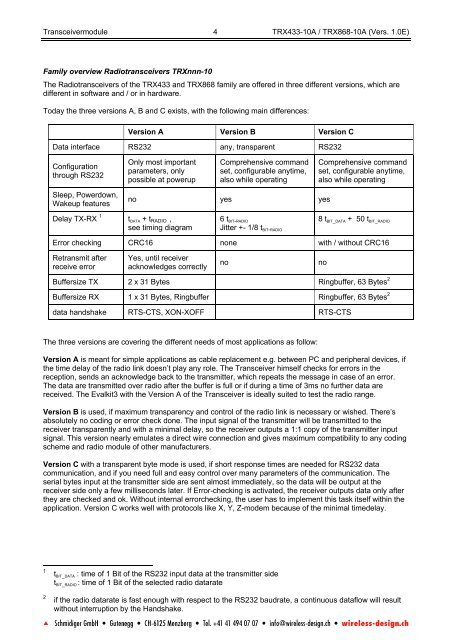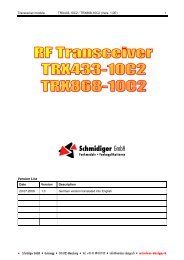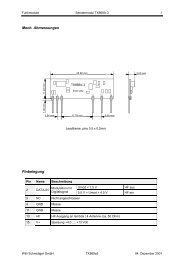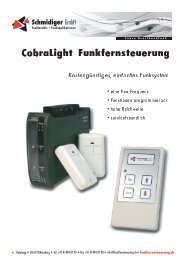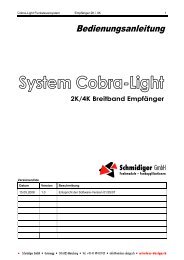Transceivermodule 1 TRX433-10A / TRX868-10A (Vers. 1.0E ...
Transceivermodule 1 TRX433-10A / TRX868-10A (Vers. 1.0E ...
Transceivermodule 1 TRX433-10A / TRX868-10A (Vers. 1.0E ...
You also want an ePaper? Increase the reach of your titles
YUMPU automatically turns print PDFs into web optimized ePapers that Google loves.
<strong>Transceivermodule</strong> 4 <strong>TRX433</strong>-<strong>10A</strong> / <strong>TRX868</strong>-<strong>10A</strong> (<strong>Vers</strong>. <strong>1.0E</strong>)<br />
Family overview Radiotransceivers TRXnnn-10<br />
The Radiotransceivers of the <strong>TRX433</strong> and <strong>TRX868</strong> family are offered in three different versions, which are<br />
different in software and / or in hardware.<br />
Today the three versions A, B and C exists, with the following main differences:<br />
<strong>Vers</strong>ion A <strong>Vers</strong>ion B <strong>Vers</strong>ion C<br />
Data interface RS232 any, transparent RS232<br />
Configuration<br />
through RS232<br />
Sleep, Powerdown,<br />
Wakeup features<br />
Only most important<br />
parameters, only<br />
possible at powerup<br />
Delay TX-RX 1 t DATA + tRADIO ,<br />
see timing diagram<br />
Comprehensive command<br />
set, configurable anytime,<br />
also while operating<br />
no yes yes<br />
6 t BIT-RADIO<br />
Jitter +- 1/8 t BIT-RADIO<br />
Comprehensive command<br />
set, configurable anytime,<br />
also while operating<br />
8 t BIT_DATA + 50 t BIT_RADIO<br />
Error checking CRC16 none with / without CRC16<br />
Retransmit after<br />
receive error<br />
Yes, until receiver<br />
acknowledges correctly<br />
no no<br />
Buffersize TX 2 x 31 Bytes Ringbuffer, 63 Bytes 2<br />
Buffersize RX 1 x 31 Bytes, Ringbuffer Ringbuffer, 63 Bytes 2<br />
data handshake RTS-CTS, XON-XOFF RTS-CTS<br />
The three versions are covering the different needs of most applications as follow:<br />
<strong>Vers</strong>ion A is meant for simple applications as cable replacement e.g. between PC and peripheral devices, if<br />
the time delay of the radio link doesn’t play any role. The Transceiver himself checks for errors in the<br />
reception, sends an acknowledge back to the transmitter, which repeats the message in case of an error.<br />
The data are transmitted over radio after the buffer is full or if during a time of 3ms no further data are<br />
received. The Evalkit3 with the <strong>Vers</strong>ion A of the Transceiver is ideally suited to test the radio range.<br />
<strong>Vers</strong>ion B is used, if maximum transparency and control of the radio link is necessary or wished. There’s<br />
absolutely no coding or error check done. The input signal of the transmitter will be transmitted to the<br />
receiver transparently and with a minimal delay, so the receiver outputs a 1:1 copy of the transmitter input<br />
signal. This version nearly emulates a direct wire connection and gives maximum compatibility to any coding<br />
scheme and radio module of other manufacturers.<br />
<strong>Vers</strong>ion C with a transparent byte mode is used, if short response times are needed for RS232 data<br />
communication, and if you need full and easy control over many parameters of the communication. The<br />
serial bytes input at the transmitter side are sent almost immediately, so the data will be output at the<br />
receiver side only a few milliseconds later. If Error-checking is activated, the receiver outputs data only after<br />
they are checked and ok. Without internal errorchecking, the user has to implement this task itself within the<br />
application. <strong>Vers</strong>ion C works well with protocols like X, Y, Z-modem because of the minimal timedelay.<br />
1 tBIT_DATA : time of 1 Bit of the RS232 input data at the transmitter side<br />
t BIT_RADIO : time of 1 Bit of the selected radio datarate<br />
2<br />
if the radio datarate is fast enough with respect to the RS232 baudrate, a continuous dataflow will result<br />
without interruption by the Handshake.


